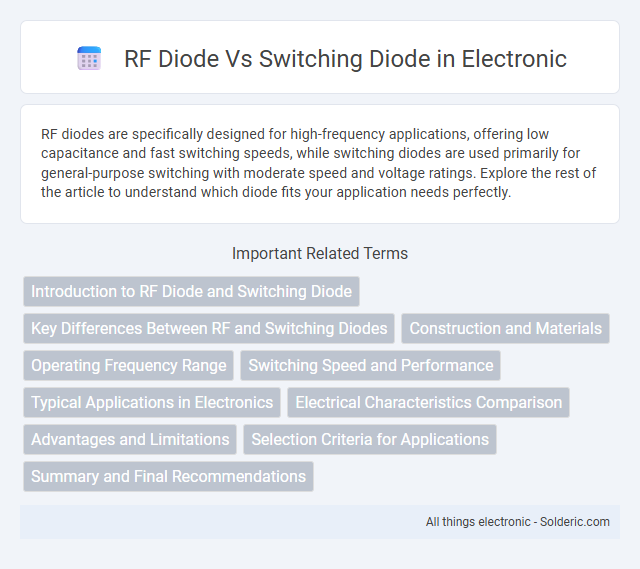RF diodes are specifically designed for high-frequency applications, offering low capacitance and fast switching speeds, while switching diodes are used primarily for general-purpose switching with moderate speed and voltage ratings. Explore the rest of the article to understand which diode fits your application needs perfectly.
Comparison Table
| Feature | RF Diode | Switching Diode |
|---|---|---|
| Primary Use | High-frequency signal detection, RF circuits | Fast switching in digital and analog circuits |
| Frequency Range | Up to several GHz | Up to hundreds of MHz |
| Junction Capacitance | Low (to minimize signal loss) | Moderate |
| Switching Speed | High | Very High (nanosecond range) |
| Forward Voltage Drop | Typically low (~0.3 to 0.7 V) | Typically low (around 0.7 V) |
| Applications | RF mixers, detectors, tuners | Logic circuits, pulse circuits, signal routing |
| Example Devices | Schottky diodes, varactor diodes tailored for RF | 1N4148, 1N914 switching diodes |
Introduction to RF Diode and Switching Diode
RF diodes and switching diodes serve distinct roles in electronic circuits, with RF diodes designed to handle high-frequency signals commonly found in radio frequency applications, ensuring minimal signal loss and fast switching capabilities. Switching diodes primarily function to open and close circuits rapidly, ideal for digital switching tasks where speed and reliability are critical. Understanding the specific applications and characteristics of each diode type can significantly enhance the performance and efficiency of your electronic designs.
Key Differences Between RF and Switching Diodes
RF diodes are specifically designed for high-frequency applications, offering low junction capacitance and fast switching speeds essential for radio frequency circuits. Switching diodes, while also capable of rapid switching, are optimized for general-purpose signal switching rather than handling RF signals with minimal distortion. Your choice depends on the required frequency range and signal integrity, with RF diodes excelling in high-frequency performance and switching diodes suited for standard switching tasks.
Construction and Materials
RF diodes are typically constructed using semiconductor materials like silicon with a focus on low junction capacitance and high-frequency performance, often incorporating planar or mesa structures for minimal parasitic inductance. Switching diodes use silicon or sometimes germanium with a design optimized for fast recovery time and low forward voltage drop, featuring a simple PN junction for rapid switching capabilities. Both types employ specific doping levels and junction depths tailored to their operational frequencies and switching speeds, impacting their construction and material composition.
Operating Frequency Range
RF diodes typically operate efficiently within high-frequency ranges, often from several megahertz up to several gigahertz, making them ideal for radio frequency and microwave applications. Switching diodes, in contrast, are designed to handle lower frequency ranges, generally up to a few hundred megahertz, where rapid on-off switching is required rather than high-frequency signal processing. Understanding the operating frequency range of these diodes helps you select the appropriate component for your specific electronic circuit needs.
Switching Speed and Performance
RF diodes offer superior switching speed compared to switching diodes, making them ideal for high-frequency applications where rapid signal modulation is crucial. Their low junction capacitance and minimal charge storage enable faster performance with reduced distortion and signal loss. When optimizing Your circuit for speed and efficiency, choosing an RF diode ensures enhanced responsiveness and reliable operation under demanding conditions.
Typical Applications in Electronics
RF diodes are primarily used in high-frequency applications such as RF signal detection, mixing, and tuning circuits due to their low junction capacitance and fast switching speeds. Switching diodes, with their ability to handle rapid on-off switching, are commonly employed in digital logic circuits, rectifiers, and pulse modulation systems. Your choice between RF and switching diodes depends on whether the application requires high-frequency performance or efficient signal switching capabilities.
Electrical Characteristics Comparison
RF diodes exhibit low capacitance and series resistance, enabling high-frequency operation typically above 100 MHz, whereas switching diodes prioritize fast recovery time with slightly higher capacitance suitable for switching applications up to a few MHz. The forward voltage drop in RF diodes is usually lower, around 0.2-0.4 V, optimizing signal integrity at high frequencies, while switching diodes have a forward voltage of approximately 0.7 V. Reverse recovery time for RF diodes can be in the picosecond to nanosecond range, significantly faster than the nanosecond to microsecond range typical for switching diodes, influencing efficiency in RF and fast-switching circuits.
Advantages and Limitations
RF diodes offer high-frequency performance and low junction capacitance, making them ideal for applications in RF switching, detection, and mixing. Switching diodes provide fast switching speeds and durability in digital circuits but may have higher losses at microwave frequencies compared to RF diodes. Your choice depends on whether high-frequency efficiency (RF diode) or fast, reliable switching in logic circuits (switching diode) is more critical for the application.
Selection Criteria for Applications
RF diodes and switching diodes are chosen based on frequency, switching speed, and power handling requirements. RF diodes excel in high-frequency applications above 100 MHz with low capacitance and fast response, making them ideal for RF signal detection and mixing. Switching diodes suit lower-frequency, fast on-off switching tasks with moderate speed and voltage, so selecting the right diode depends on Your application's operating frequency and signal integrity needs.
Summary and Final Recommendations
RF diodes are specifically designed to operate efficiently at high frequencies, offering low capacitance and fast switching speed suitable for radio frequency applications. Switching diodes excel in low to medium frequency circuits where rapid on/off switching and low forward voltage drop are critical. For your high-frequency communication needs, an RF diode is ideal, while switching diodes are better suited for digital circuits and general switching tasks.
RF diode vs Switching diode Infographic

 solderic.com
solderic.com